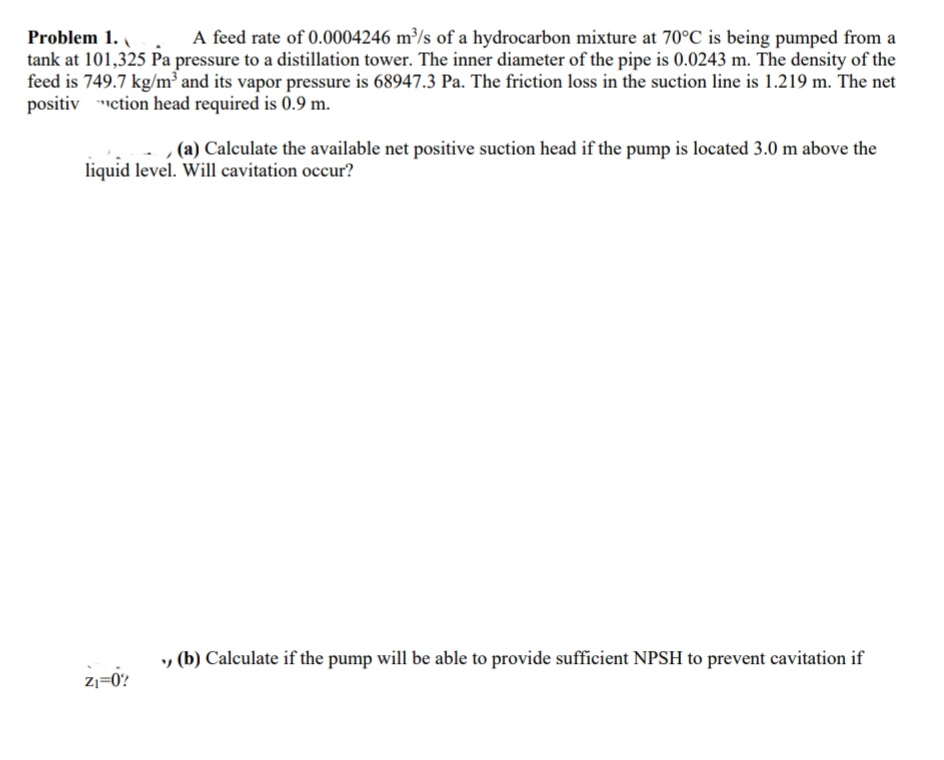Problem 1.. tank at 101,325 Pa pressure to a distillation tower. The inner diameter of the pipe is 0.0243 m. The density of the feed is 749.7 kg/m and its vapor pressure is 68947.3 Pa. The friction loss in the suction line is 1.219 m. The net positiv "ction head required is 0.9 m. A feed rate of 0.0004246 m³/s of a hydrocarbon mixture at 70°C is being pumped from a , (a) Calculate the available net positive suction head if the pump is located 3.0 m above the liquid level. Will cavitation occur?
Problem 1.. tank at 101,325 Pa pressure to a distillation tower. The inner diameter of the pipe is 0.0243 m. The density of the feed is 749.7 kg/m and its vapor pressure is 68947.3 Pa. The friction loss in the suction line is 1.219 m. The net positiv "ction head required is 0.9 m. A feed rate of 0.0004246 m³/s of a hydrocarbon mixture at 70°C is being pumped from a , (a) Calculate the available net positive suction head if the pump is located 3.0 m above the liquid level. Will cavitation occur?
Refrigeration and Air Conditioning Technology (MindTap Course List)
8th Edition
ISBN:9781305578296
Author:John Tomczyk, Eugene Silberstein, Bill Whitman, Bill Johnson
Publisher:John Tomczyk, Eugene Silberstein, Bill Whitman, Bill Johnson
Chapter40: Typical Operating Conditions
Section: Chapter Questions
Problem 10RQ: The seasonal energy efficiency ratio (SEER) includes the energy used in the _____and _____cycles.
Related questions
Question
Heat Transfer Question
Pumps

Transcribed Image Text:Problem 1.
tank at 101,325 Pa pressure to a distillation tower. The inner diameter of the pipe is 0.0243 m. The density of the
feed is 749.7 kg/m² and its vapor pressure is 68947.3 Pa. The friction loss in the suction line is 1.219 m. The net
positiv ction head required is 0.9 m.
A feed rate of 0.0004246 m³/s of a hydrocarbon mixture at 70°C is being pumped from a
(a) Calculate the available net positive suction head if the pump is located 3.0 m above the
liquid level. Will cavitation occur?
, (b) Calculate if the pump will be able to provide sufficient NPSH to prevent cavitation if
Z1=0?
Expert Solution
This question has been solved!
Explore an expertly crafted, step-by-step solution for a thorough understanding of key concepts.
This is a popular solution!
Trending now
This is a popular solution!
Step by step
Solved in 3 steps

Knowledge Booster
Learn more about
Need a deep-dive on the concept behind this application? Look no further. Learn more about this topic, mechanical-engineering and related others by exploring similar questions and additional content below.Recommended textbooks for you

Refrigeration and Air Conditioning Technology (Mi…
Mechanical Engineering
ISBN:
9781305578296
Author:
John Tomczyk, Eugene Silberstein, Bill Whitman, Bill Johnson
Publisher:
Cengage Learning

Automotive Technology: A Systems Approach (MindTa…
Mechanical Engineering
ISBN:
9781133612315
Author:
Jack Erjavec, Rob Thompson
Publisher:
Cengage Learning

Refrigeration and Air Conditioning Technology (Mi…
Mechanical Engineering
ISBN:
9781305578296
Author:
John Tomczyk, Eugene Silberstein, Bill Whitman, Bill Johnson
Publisher:
Cengage Learning

Automotive Technology: A Systems Approach (MindTa…
Mechanical Engineering
ISBN:
9781133612315
Author:
Jack Erjavec, Rob Thompson
Publisher:
Cengage Learning